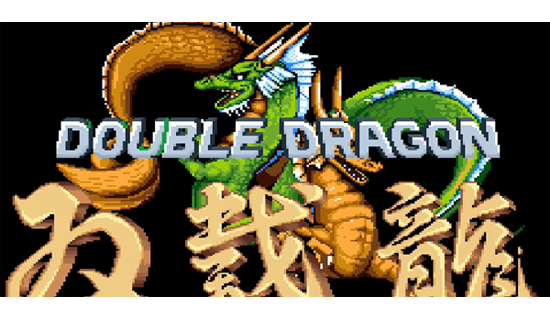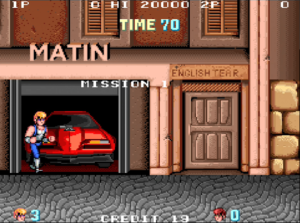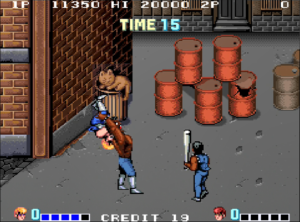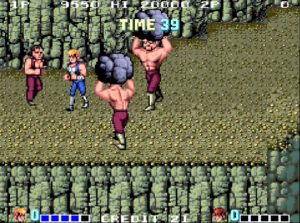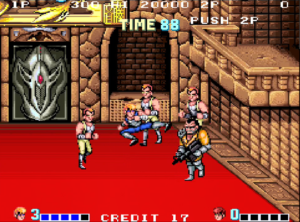Yoshihisa Kishimoto and his team significantly evolved the beat-em-genre with Nekketsu Kouha Kunio kun/Renegade in 1986. Technos Japan naturally wanted them to make more of these games, so they were tasked with just that. June 1987 would be the arcade birth of not only an even bigger success for Technos Japan than Kunio kun, but also the birth of another beat-em-up franchise and further evolution of the genre: Double Dragon. Originally envisioned as a direct sequel to Kunio kun, Kishimoto was given two mandates: This game should allow for 2 players simultaneously and have a bigger international appeal. Given that Kunio kun had to be visually gutted in order to sell it overseas as Renegade, a direct sequel was pretty much out of the question. So instead of taking inspiration from the Tsuppari genre and his own high school fighting experiences, Kishimoto pulled from another source that was dear to him: Bruce Lee. He particularly loved “Enter the Dragon”, and so he came up with not only the title of the game but also the names of the protagonists (Billy and Jimmy Lee) from these sources.
This time around, the main character’s motivation for fighting isn’t revenge for a friend getting beaten up, but rather rescuing Billy’s girlfriend Marian who has kidnapped by a gang called the Black Warriors, as a means of challenge to the dojo that they’ve inherited (their dojo isn’t actually inside of the garage that they come out of at the beginning, is it?!). A significantly different graphical style is also used, and of course Double Dragon does allow for two players simultaneously. Levels still give you free up/down/left/right movement as they did before. Instead of being small self contained screens that are transitioned between only by going through doors though, the level progresses by moving on further to the right after you’ve defeated requisite groups of enemies. This is more of a marriage between Spartan X’s idea of continuously moving in one direction and Kunio kun’s idea of more free movement. The biggest change is found in the game play itself: Instead of the direction of attack being different for a punch or a kick, it’s determined by the direction in which the player character is facing. This makes for a much more intuitive control scheme than before. There are also an even greater variety moves to choose from: The standard punch, kick and jump kick return along with a back-facing elbow smash (the secret to winning in the arcade game), and a grab that gives you the choice between a throw or just pummeling the enemy with your fists. Weapons such as whips, knives, boxes and boulders can be picked up and used against enemies as well. But beware, they can also use them against you.
Though it’s not as difficult upfront as Nekketsu Kouha Kunio kun due to the more intuitive control scheme, it quickly becomes more the more challenging game. There are a lot of enemies on screen at most points (this results in frequent and noticeable slowdown that’s present even on the original arcade board), and they’re all fairly aggressive. The amount of enemies also doesn’t scale based on whether you’re playing one or two players. Thankfully, Double Dragon does have an attack that’s practically guaranteed to get you through without too much trouble, as long as you get the timing down: The elbow smash. No other attacks are really worth using, because you’ll get knocked out of all of them by even the most common enemies. The elbow is also an instant knockdown on any enemy, so just keep using it if you want to get through the game.
There’s no denying that Double Dragon was every bit as important of a landmark in the beat-em-up genre as Spartan X or Nekketsu Kouha Kunio kun, and is more widely remembered worldwide than either one. It would act as a more exact template for most beat-em-ups going forward, including Technos Japan’s own games outside of the Double Dragon series. It’s also just a fun game to play, particularly a version that allows for two players. That being said, it doesn’t have a very strong identity or aesthetic. It’s an easier game to play and is more evolved than Nekketsu Kouha Kunio kun is, but it just doesn’t have the same personality and charm.
Double Dragon may be one of the most ported games ever. Within a few years of its release it appeared on Famicom/NES, Atari 2600, Atari 7800, Atari ST, Amiga, Commodore 64, Amstrad CPC, Game Boy, Mega Drive/Genesis, Mark III/Master System, Game Gear, Lynx, PC, and the Sinclair ZX81/Spectrum. Later in life it would also be ported to various mobile phone platforms, Game Boy Advance, XBox 360 (as an XBox Live downloadable title), and PlayStation 4 via Hamster’s Arcade Archives collection. Most of these made no real attempt to emulate the arcade experience, and instead were their own things that sort of resembled the original.
